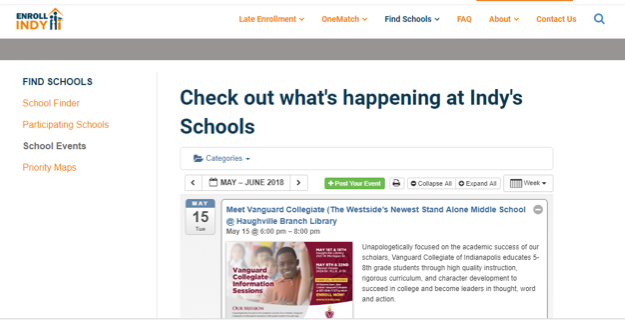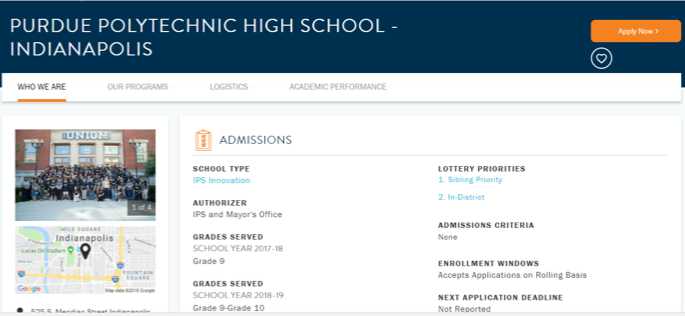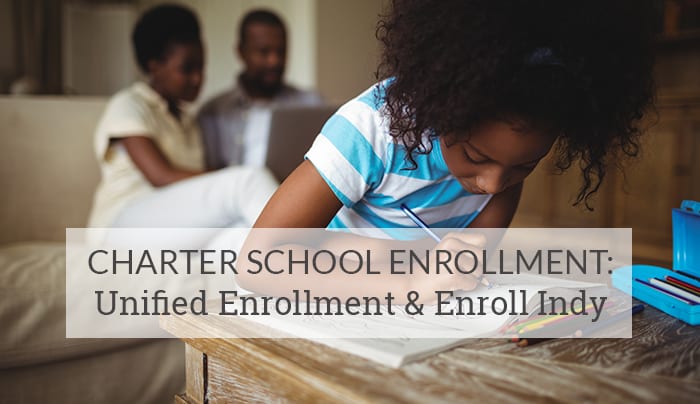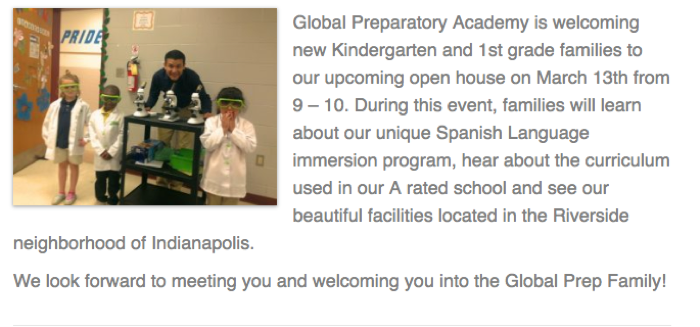Charter School Enrollment: Unified Enrollment and Enroll Indy
Thirty years ago, the process for selecting and enrolling in a school was very easy. Parents would send their child to the neighborhood public school, or if they had the means and/or desire would choose to apply to a private and/or parochial school. With the introduction and growth of charter schools, choosing a school is now a more involved and often a complex decision. Though some would say that the free market approach to school choice – and the option for charter school enrollment – is good, others have suggested that it has created a challenging system that disproportionately skews towards parents who have the time and ability to ensure that their child gets into the best school.
In an attempt to address these concerns and simplify what had become a very complex process, cities are turning to unified enrollment systems which provide parents a single place to research schools, a common application and single process to “match” to the school of their choice.
Denver and New Orleans were the first to roll these out in 2011. Both systems were able to pull together both traditional public school enrollment and public charter school enrollment into a single, common system. New Orleans also included their private schools. Since then, other cities like Washington DC, Camden and Newark have instituted this unified enrollment system across both traditional public schools and public charter schools while others like Detroit, St. Louis and Kansas City have created these systems without traditional public school participation and only include the public charter schools.
Early research of the Denver system has shown that this program has brought more equity to the group of schools who participate with higher enrollment of minorities, lower-income students and English language learners to the charter sector.
However, the move to common enrollment has not been without controversy. In Boston and Oakland, the implementation of unified enrollment has been stifled by concerns about charter school expansion, believing that the implementation of a unified system will drive more students away from the local traditional public schools.
Recognizing some of the challenges that other cities had faced in rolling out unified enrollment, Indianapolis was very deliberate about garnering community support of a unified enrollment program. In the fall of 2017, Enroll Indy was launched with substantial support from the two key local players in education: The Mind Trust and the Mayor’s Office of Charter Schools. Caitlin Hanlon, the founder of Enroll Indy, was a Mind Trust fellow and had structured the system during her fellowship.
The organization conducted a well-designed community outreach program prior to launch. This outreach garnered support from many well-known neighborhood organizations, civic groups, and schools. In its first year, a total of 57 schools participated in Enroll Indy. This included all the Indianapolis Public Schools (IPS) and most of the larger charter schools in the city. — few notable exceptions included the Christel House schools and the charter (non-innovation schools) of Phalen Leadership Academy.
Under the Enroll Indy system, any kindergarten or above student who is changing schools to a school that participates in the system is required to register with the Enroll Indy website and indicate their priority choice for a school. They are then matched to a school based upon their priority choices and the space available at the school.
Enroll Indy has changed the enrollment and recruitment dynamics within the city of Indianapolis. As a school enrollment consultant, I had the opportunity to work with several clients in Indianapolis during the roll-out. I wanted to share some of our experiences and ways that schools can maximize their recruitment efforts in a unified enrollment environment.
1. It is going to be harder to enroll students if you choose to operate outside of Enroll Indy.
As a charter school leader in Indianapolis, or really in any unified enrollment system, you need to ask the fundamental question: Should we participate in this system for our charter school’s enrollment? This is a judgment call based upon the success and quality of the existing enrollment strategy for your charter school. If you have a well-designed enrollment system, consistently have a waiting list, and can communicate to all prospects that they don’t need to use Enroll Indy to enroll in your school, you might be able to run independently. As I stated above, a couple of schools are going this route. However, generally, there are more positives (for the expansion of charter schools) than negatives to be gained from Enroll Indy, so I recommend to my clients that they participate. If you choose to operate independently, you are going to have to overcome the perception that all schools are part of this system. This can be done, but it will require more work. Enroll Indy participated in over 60 community events and did phone banking /canvasing of over 25,000 households in Center Township. That is tough to compete against.
If you choose to participate:
2. You need to be thoughtful and strategic about the information that you include on your school description
For a lot of parents, your page under the Enroll Indy school finder site may be the first time that they have heard about your school or have seen detailed information about what your school offers.

The “Who We Are” section is your opportunity to make a great first impression. This section needs to be exciting and resonate with your potential parents. DO NOT take the description in your charter application and copy and paste! You need to think about who your audience is and what they want in a school. Many of the descriptions that I read from schools were chock full of academic jargon like “…leading literacy socio-emotional and neuroscientific research..” or were not very exciting like “We incorporate the environment into our instruction, and our students have opportunities for outdoor education.” Give your prospective parents an easy to understand but also a compelling description of your school. You are describing your school, but also selling it. Global Preparatory Academy, a dual language immersion program on the Near Westside, provides a good example of a parent-friendly description:
Example description from Global Preparatory Academy
Next, in the school highlights section, you can select six pictures and categories that highlight the uniqueness of your school. There were a few schools who struggled with this part. I saw a few that displayed their school mascot, or just the exterior of the facility. Those are important, but in this key selling stage, you want to continue to describe your school, but use the visuals to create excitement and allow the parent to envision their child at your school.
Don’t use stock photography or leave this section blank. Take this part seriously because parents are taking this seriously.
Finally, make sure that you are filling out all the different programs, clubs, sports and community partnerships that your school provides. Though the filtering program allows parents to search on a specific type of activity that your school offers, right now that filter does not “knock” a school off the consideration list, so it doesn’t remove you from consideration. However, if you don’t fill this section out, you give a very incomplete picture of your school.
Example of a school that is not very enticing
3. Utilize the event feature and participate in all the events that Enroll Indy hosts
Enroll Indy hosted four of events in the six months of the matching period. Attending these events gives you an excellent opportunity to get in front of parents who are currently looking for a school.
In addition to hosting their own events, Enroll Indy also allowed schools to use their platform to advertise upcoming open houses or other recruitment events. Surprisingly, only about a quarter of the schools used Enroll Indy to publicize their events.

Enroll Indy’s website averages about 2,000 users a month. This is a great (and free) platform for you to advertise your events. Additionally, in the monthly newsletters that Enroll Indy sends out to their entire parental database, they highlight and promote these events. Because my clients had events listed on the site, they were profiled in the newsletter. If you don’t list your events, you don’t get that opportunity.
4. Utilize the “like” or favorite feature to understand who is interested in your school
One of the complaints that I heard from schools using Enroll Indy was not being able to see who is interested in their school until they were matched. However, on your school page in the upper right corner, there is a heart, or a favorite, button.

Note the “like” button (heart) on the top right-hand corner
When a parent “likes” your school, they go into a separate list that you can access prior to match day to follow up with that parent. This is the only time you are going to see contact information for a parent prior to the official matching time. Encourage all your parents that you are recruiting to “like you”. This can be done in the description of your school or through your promotional efforts outside of Enroll Indy. Once you have a parent’s contact information, you need to follow up with the parents who have signaled a preference towards your school. Email them, call them, send them more information, personally invite them to an event, etc. They are giving you a buying signal, go out and court them. A personal outreach at this stage is going to make a huge impact on how they view your school.
5. Enroll Indy will not be a silver bullet if you constantly struggle with enrollment. You must still do the work!
Enroll Indy’s goals are not to ensure full enrollment at every school, but rather to try to spread enrollment more equally and equitably across all the schools in Indianapolis. Enroll Indy can help communicate to new parents who might not have heard about your school, but it should not in any way encourage you to stop doing all the recruitment activities that you have done in the past to attract students. It is a great addition to your marketing toolkit, but it shouldn’t be your sole tactic.
It is too soon to confidently talk about the impact that Enroll Indy will have upon education and enrollment within Indianapolis. However, if you are a charter school in Indianapolis, maximizing Enroll Indy should be a factor in the planning of your enrollment strategy. Hopefully, these five tips can help you to maximize it for your school.
Nick LeRoy, MBA, is the president of Bright Minds Marketing and former Executive Director of the Indiana Charter School Board. Bright Minds Marketing provides enrollment and recruitment consulting to private, Catholic and charter schools. For information about how Bright Minds Marketing can help your school improve its’ student enrollment, send an email to nick@brightmindsmarketing.com or call them at 317-361-5255.
 Digital Marketing for Charter Schools: An Actionable Workbook to Help You Achieve Your School’s Goals!
Digital Marketing for Charter Schools: An Actionable Workbook to Help You Achieve Your School’s Goals!
Scratching your head as to how to go about building messaging for your charter school? You’re not alone! This free manual will be your go-to guide for all of your school’s digital marketing needs! Download this actionable workbook to help get your marketing plans outlined and started, guide you as you define your audience, key differentiators and messaging, choose your tactics, and start to build your campaigns.




